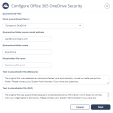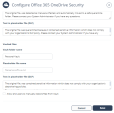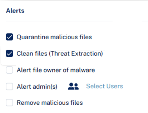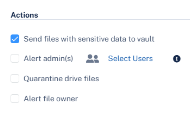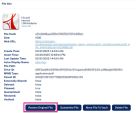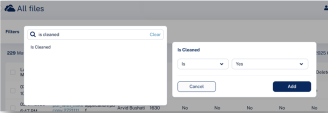Office 365 OneDrive
Overview
Office 365 OneDrive is a cloud storage system that allows sharing files and collaboration. Harmony Email & Collaboration adds security, privacy, and compliance to Office 365 OneDrive by scanning files shared in OneDrive for malicious content and data loss prevention (DLP) and generates actionable events on malicious content.
|
|
Note - Harmony Email & Collaboration scans only the organization's Office 365 OneDrive and does not scan files and folders outside the organization, even if user has access to them. |
How it works
Harmony Email & Collaboration adds a layer of security that provides these security features for Office 365 OneDrive:
-
Data Leak Prevention (DLP): Protects sensitive text messages and files
-
Anti-Malware: Scans of files for malicious content
-
Remediation: Quarantines malicious files and send files containing sensitive data to the vault
Harmony Email & Collaboration scans files in the following scenarios:
-
A new file is created
-
A file is uploaded
-
A file is modified (edited)
-
A file or directory is shared with new members
|
|
Note - Harmony Email & Collaboration starts scanning files from the time of installation. Files that existed prior to installation are not scanned retroactively. |
Required Permissions
Harmony Email & Collaboration requires these permissions to protect Office 365 OneDrive.
|
|
Note - All these permissions are required to access your data in the Harmony Email & Collaboration Administrator Portal. |
|
Permissions required from Microsoft |
Functions performed by Harmony Email & Collaboration |
|---|---|
|
Manage all access reviews |
Allows the app to read, update, delete and perform actions on access reviews, reviewers, decisions, and settings in the organization without a signed-in user. |
|
Read and write all applications |
Allows the app to create, read, update and delete applications and service principals without a signed-in user. Does not allow management of consent grants. |
|
Read and write contacts in all mail boxes |
Allows the app to create, read, update, and delete all contacts in all mailboxes without a signed-in user. |
|
Read and write directory data |
Allows the app to read and write data in your organization's directory, such as users, and groups, without a signed-in user. Does not allow user or group deletion. |
|
Read and write domains |
Allows the app to read and write all domain properties without a signed-in user. Also allows the app to add, verify and remove domains. |
|
Read and write files in all site connections |
Allows the app to read, create, update and delete all files in all site collections without a signed-in user. |
|
Read and write all groups |
Allows the app to create groups, read all group properties and memberships, update group properties and memberships, and delete groups. Also allows the app to read and write group calendar and conversations. All of these operations can be performed by the app without a signed-in user. |
|
Read and write all user mailbox settings |
Allows the app to create, read, update, and delete user's mailbox settings without a signed-in user. Does not include permission to send mail. |
|
Read and write mail in all mailboxes |
Allows the app to create, read, update, and delete mail in all mailboxes without a signed-in user. Does not include permission to send mail. |
|
Send mail as any user |
Allows the app to send mail as any user without a signed-in user. |
|
Read all usage reports |
Allows an app to read all service usage reports without a signed-in user. Services that provide usage reports include Microsoft 365 and Microsoft Entra ID (formerly Azure AD). |
|
Read and update your organization’s security events |
Allows the app to read your organization’s security events without a signed-in user. Also allows the app to update editable properties in security events. |
|
Read and write items in all site collections |
Allows the app to create, read, update, and delete documents and list items in all site collections without a signed-in user. |
|
Read and write all users' full profiles |
Allows the app to read and update user profiles without a signed-in user. |
|
Sign in and read user profile |
Allows users to sign in to the app, and allows the app to read the profile of signed-in users. It also allows the app to read basic company information of signed-in users. |
How to Activate Office 365 OneDrive
To activate Office 365 OneDrive, see Activating Office 365 OneDrive.
How to Deactivate Office 365 OneDrive
To deactivate Office 365 OneDrive:
Office 365 OneDrive Security Settings
How to Customize Quarantine and Vault Folders
Administrators can customize the Quarantine and Vault folders (folder names, quarantine/vault messages and more).
What is the Quarantine Folder
The Quarantine folder stores quarantine malware-infected or sensitive files from OneDrive. It quarantines files from all users and places them in a single predefined quarantine folder for the entire organization.
You can configure the Threat Detection policy and DLP policy to quarantine only malware while sending sensitive files to the end user's Vault.
|
|
Notes:
|
To customize the Quarantine folder:
-
Go to Security Settings > SaaS Applications.
-
Click Configure for Office 365 OneDrive.
-
Go to Quarantined Files section.
-
In the Store quarantined files in section, select where you want to store the quarantined files:
-
Check Point - Stores the quarantined files in the Check Point cloud in the region associated with your organization’s Infinity Portal account.
-
Company’s OneDrive - Stores the quarantined files in a Quarantine folder located in your organization’s OneDrive account.
-
-
If you selected Company's OneDrive in the previous step, enter the following details for the quarantine folder:
-
In the Quarantine folder owner email address field, enter the required email address.

Note - Ensure that the OneDrive account for the provided email address.
-
In the Quarantine folder name field, enter the required folder name.

Note - The system creates a Quarantine folder with the specified name in the root directory of the given email address.
-
-
(Optional) To customize the content of the file that replaces the quarantined malicious file in its original folder, enter the text in the Text in placeholder file (Malware) field.
-
(Optional) To customize the content of the file that replaces the quarantined sensitive file in its original folder, enter the text in the Text in placeholder file (DLP) field.
-
Click Save.
What is the Vault Folder
The Vault folder remediates DLP detections related to OneDrive files.The system creates a non-shared Vault folder for each OneDrive user.
If a file contains sensitive information that does not comply with your organization's data-sharing policies, the system removes it and places it in the user's Vault folder.
|
|
Notes:
|
To customize the Vault folder:
-
Go to Security Settings > SaaS Applications.
-
Click Configure for Office 365 OneDrive.
-
Go to Vaulted Files section.
-
In the Vault folder name field, enter the required vault folder name.

Note - The system creates the Vault folder gets created with the specified name in the root directory of each user.
-
If you want to allow end users to manually restore files from the Vault, enable the Allow end users to manually restore files from Vault checkbox.
-
(Optional) To cutomize the content of the file that replaces the vaulted sensitive file in its original folder, enter the text in the Text in placeholder file (DLP) field.
-
Click Save.
How to Configure Office 365 OneDrive Policy
Malware Policy
By default, the Office 365 OneDrive malware policy scans the uploaded or edited files for malicious content.
What Actions are Supported
Office 365 OneDrive malware policy supports these actions:
-
Quarantine/removal of malware-infected files.
-
Alert owner: Sends an email notification to the user who uploaded a file that contains malicious content.
-
Alert admin(s): Sends an email notification to the admin(s) about the malicious files.
How to Configure Malware Policy
To configure Malware policy:
-
Access the Harmony Email & Collaboration Administrator Portal.
-
From the left navigation panel, click Policy.
-
Click Create New Policy Rule.
-
From the Choose SaaS drop-down list, select Office 365 OneDrive.
-
From the Choose Security drop-down list, select Malware and click Next.
-
Select the desired protection mode:
-
Detect and Remediate
-
Detect
(Optional) If required, you can change the Rule Name.
-
-
In the Scope section, select the users and/or group of users for whom the policy is applicable:
-
To apply the policy to all users and groups in your organization, enable All Users and Groups checkbox.
-
To apply the policy to specific users or groups, select the users/ groups and click Add to Selected.
-
To exclude specific users or groups from the policy, select the required users/groups and click Add to Excluded.
-
-
In the Blades section, select the required threat detection blades for the policy.

Note - To select all the blades available for malware detection, enable All running threat detection blades checkbox.
-
Scroll down to Attachments section and select the required workflow for the policy in the Suspected malware attachments workflow.
-
Quarantine. User is not alerted (admin can restore)
-
Do nothing

Note - The Workflows are available only when Detect and Remediate protection mode is enabled.
-
-
To quarantine malware-infected files, enable the Quarantine drive files checkbox under Alerts.

Note - This option is available only in Detect and Remediate protection mode.
-
To remove malware-infected files, enable the Remove malicious files checkbox under Alerts.

Notes:
-
If you enable the Remove malicious files checkbox, malicious files will be removed permanently, and you cannot restore them.
-
For a policy, you can only enable Quarantine drive files or Remove malicious files.
-
-
Configure Alerts for the policy.
-
To quarantine malware-infected files, enable the Quarantine malicious files checkbox in the Alerts section.

Note -This option is available only in Detect and Remediate protection mode.
-
To clean malicious files, enable the Clean Files (Threat Extraction) checkbox. See File Cleaning (Threat Extraction) for Office 365 OneDrive and Office 365 SharePoint.

Note - If the Clean files (Threat Extraction) checkbox is not available in your Infinity Portal account (tenant), contact Check Point Support .
-
To send email alerts to the file owner of malware, enable the Alert file owner of malware checkbox.
-
To send email alerts to admins about malware, enable the Alert admin(s) checkbox.
To configure alerts to the specific users, click Select Users next to the Alert admin(s).
-
To remove malware-infected files, enable the Remove malicious files checkbox in the Alerts section.

Note - If you enable the Remove malicious files checkbox, malicious files will be removed permanently, and you cannot restore them.

Notes:
-
For a policy, you can only enable Quarantine malicious files or Remove malicious files.
-
Even when the alerts are enabled here in the policy, the administrator only receives email alerts for security events when Receive Alerts role is enabled in the Specific Service Role. For more details about managing roles and permissions in the Infinity Portal, refer to Global Settings > Users in Infinity Portal Administration Guide.
-
-
Click Save and Apply.
DLP Policy
By default, the DLP policy scans the uploaded files to OneDrive for potentially leaked information, such as credit card number and Social Security Number (SSN).
What Actions are Supported
Office 365 OneDrive DLP policy supports these actions:
-
Send files with sensitive data to the vault.
-
Alert owner: Sends an email notification to the user who uploaded a file that contains sensitive information.
-
Alert admin(s): Sends an email notification to the admin(s) about the files that contain sensitive information.
How to Configure DLP Policy for OneDrive
To configure DLP policy:
-
Access the Harmony Email & Collaboration Administrator Portal.
-
From the left navigation panel, click Policy.
-
Click Create New Policy Rule.
-
From the Choose SaaS drop-down list, select Office 365 OneDrive.
-
From the Choose Security drop-down list, select DLP and click Next.
-
Select the desired protection mode:
-
Detect and Remediate
-
Detect
(Optional) If required, you can change the Rule Name.
-
-
In the Scope section, select the users and/or group of users for whom the policy is applicable:
-
To apply the policy to all users and groups in your organization, enable All Users and Groups checkbox.
-
To apply the policy to specific users or groups, select the users/ groups and click Add to Selected.
-
To exclude specific users or groups from the policy, select the required users/groups and click Add to Excluded.
-
-
Scroll down to the DLP Criteria, enable Check Point DLP Categories and select the required DLP categories for the policy.
For more information about the DLP Data Types and categories, see Appendix D: DLP Built-in Data Types and Categories.
-
Select the required sensitivity level for the policy.
-
Very high (hit count > 0)
-
High (hit count > 2)
-
Medium (hit count > 5)
-
Low (hit count > 10)
-
Very Low (hit count > 20)
-
-
To exclude DLP policy for the files shared only with the internal users, enable the Skip Internal items checkbox.
-
Configure Actions for the policy.
-
To send a detected file with sensitive data to its owner’s vault, enable the Send files with sensitive data to vault checkbox.

Note - This option is available only in Detect and Remediate protection mode.
-
To send email alerts to admins about DLP, enable the Alert admin(s) checkbox.
To configure alerts to the specific users, click Select Users next to the Alert admin(s).
-
To quarantine drive files, enable the Quarantine drive files checkbox.

Note - This option is available only in Detect and Remediate protection mode.
-
To send email alerts to the file owner about DLP, enable the Alert file owner(s) checkbox.

Notes:
-
For a policy, you can only enable Send file with sensitive data to vault or Quarantine drive files.
-
Even when the alerts are enabled here in the policy, the administrator only receives email alerts for security events when Receive Alerts role is enabled in the Specific Service Role. For more details about managing roles and permissions in the Infinity Portal, refer to Global Settings > Users in Infinity Portal Administration Guide.
-
-
Click Save and Apply.
How to View Office 365 OneDrive Security Events
Harmony Email & Collaboration record OneDrive detections as security events. The event type depends on the type of policy that created the event. You can handle security events in different ways, whether they are detected/prevented automatically or discovered by the administrators if not prevented.
The Events screen shows a detailed view of all the security events.
|
|
Note - Microsoft prevents access to files it marks as malware and does not provide scan results for them. |
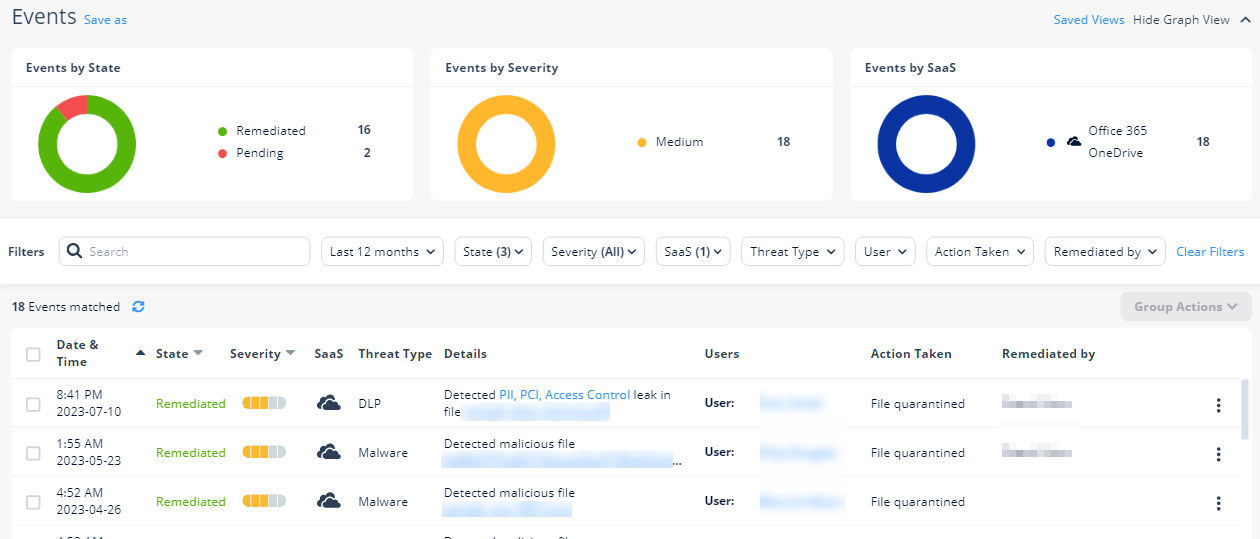
File Cleaning (Threat Extraction) for Office 365 OneDrive and Office 365 SharePoint
File cleaning (Threat Extraction) uses a Content Disarm and Reconstruction (CDR) engine as an additional layer of security alongside the Anti-Malware engine to prevent malware attacks and their spread among internal users.
The system scans every file uploaded to or edited in Office 365 OneDrive or SharePoint.
-
If malware is detected, Harmony Email & Collaboration applies the malware workflow.
-
If no malware is found, it sanitizes the file by removing active components that may conceal undetected threats.
If required, administrators can restore the original file to ensure business continuity.
For more information about file cleaning, see Attachment Cleaning (Threat Extraction).
Configuring File Cleaning (Threat Extraction) for Office 365 OneDrive or Office 365 SharePoint
To configure file cleaning for Office 365 OneDrive or Office 365 Sharepoint:
-
Access the Harmony Email & Collaboration Administrator Portal.
-
From the left navigation panel, click Policy.
-
Open the existing malware policy for the required SaaS application (Office 365 OneDrive or Office 365 SharePoint).
-
Select the policy protection mode as Detect and Remediate.
-
Scroll-down to the Alerts section, and select the Clean Files (Threat Extraction) checkbox.

Note - If the Clean files (Threat Extraction) checkbox is not available in your Infinity Portal account (tenant), contact Check Point SupportAvanan Support .
-
Click Save and Apply.
Cleaned Office 365 OneDrive / Office 365 SharePoint Files
When Harmony Email & Collaboration cleans files in Office 365 OneDrive or Office 365 SharePoint, it makes the following changes to the files:
-
Adds the string .cleaned to the file name (For example, file.doc becomes file.cleaned.doc).
-
Removes all active content from the file.
For more information about supported file types and details of the components removed from the files, see Supported file types for Attachment Cleaning (Threat Extraction).
Restoring the Original File
Administrators can restore the original file through the Harmony Email & Collaboration Administrator Portal. To do that:
-
Go to User Interaction > Quarantined Items.
-
From the drop-down list next to the Quarantined Items, select Office 365 OneDrive or Office 365 SharePoint.
-
Open the relevant File Info page, and click the Restore Original File option to restore the original file.

Note - If an end user needs access to the original file (without cleaning), they must contact an administrator, as there is no option available for them to restore it on their own.
If multiple versions of the same file exist, only the first (original) version can be restored. See Restoring Files that are Cleaned Multiple Times.
Restoring Files that are Cleaned Multiple Times
When you restore a file, Harmony Email & Collaboration always restores the first version it scanned, regardless of how many times the file was edited or cleaned later.
Since the file is cleaned every time it’s modified, the version restored may be older than the one the end user last saw.
For example, if you restore a file, the system will restore the original version of the file—potentially older than the version they last accessed. The file is cleaned each time it is modified, ensuring security at every stage.
Viewing Cleaned Files for Office 365 OneDrive and Office 365 SharePoint
To view Office 365 OneDrive or Office 365 SharePoint files that are cleaned by Harmony Email & Collaboration:
-
Go to Analytics > Custom Queries.
-
Click Create New Query at the to right corner.
-
In the Select Template for New Query page that appears, select Office 365 OneDrive or Office 365 SharePoint, then click All Files.
-
In the All Files page that appears, click Add Filters in the left top corner.
-
Select Is Cleaned is Yes, and click Add.


